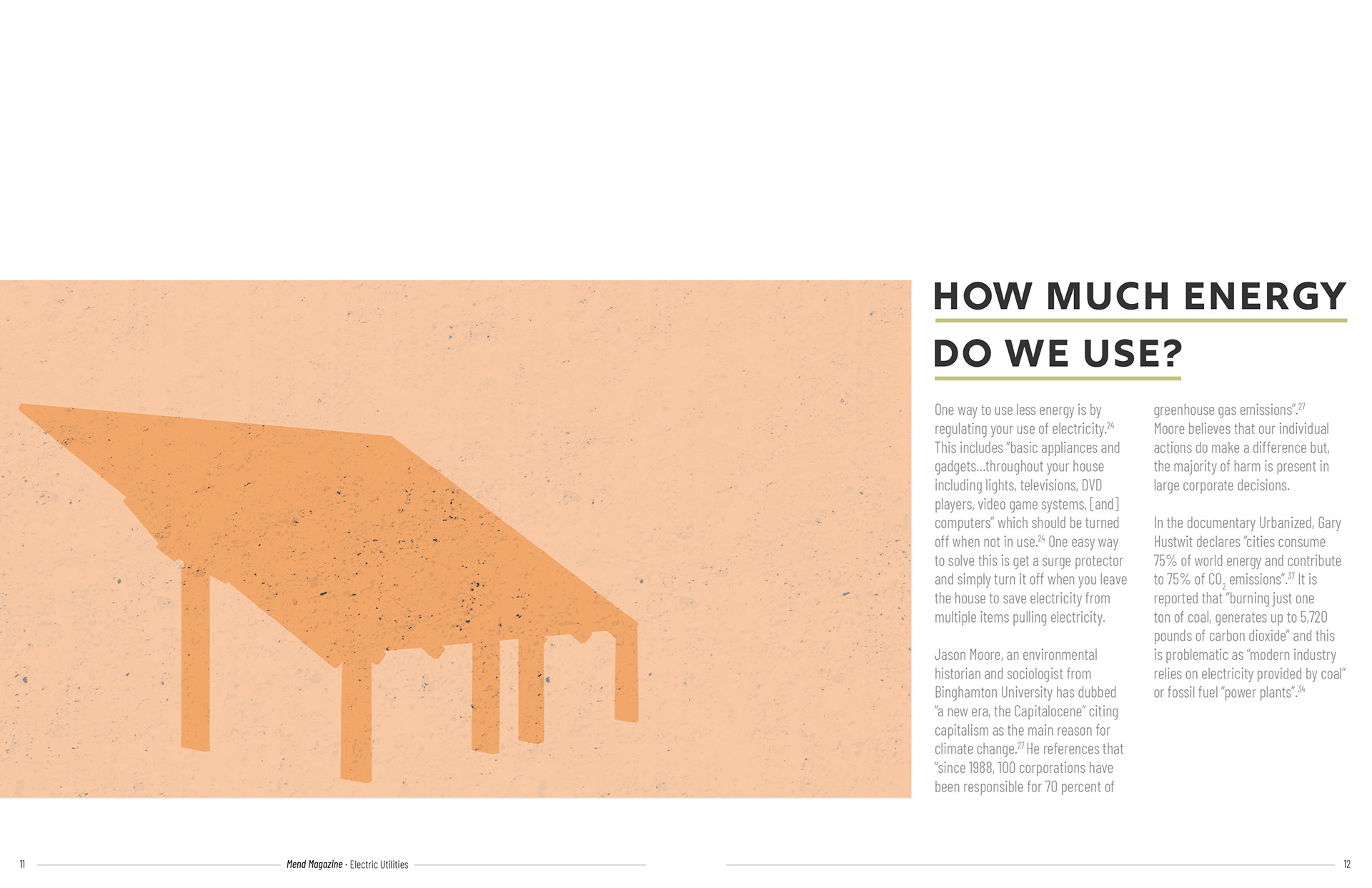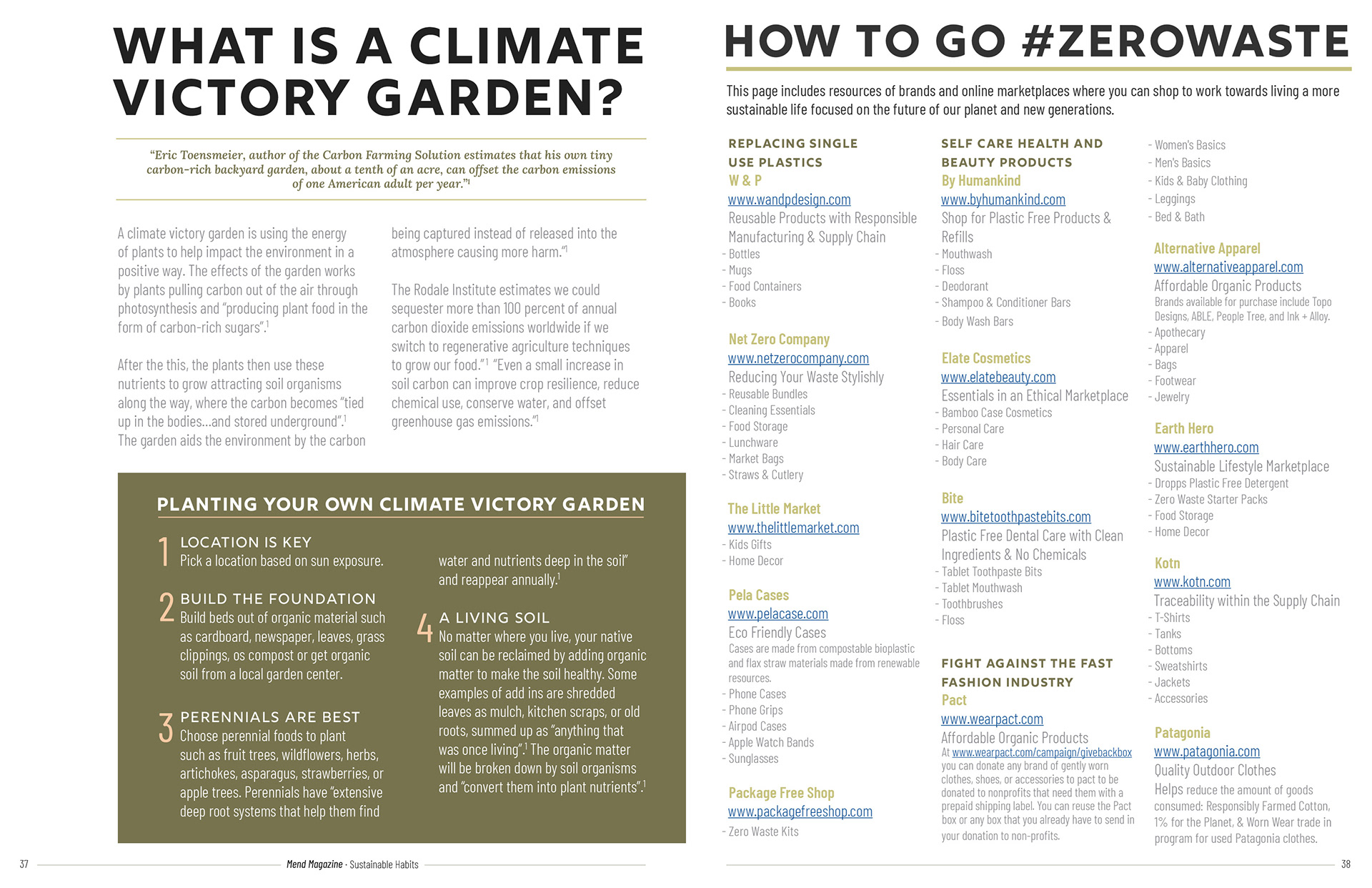Prompt
Climate change is a rising problem.
Problem
Individuals are not aware of how a deeper connection between consumption and climate change is interrelated to their daily actions.
Solution
Combining the Millennial generation’s leverage in the climate crisis there is opportunity for current and future generations to establish better habits early on. By creating a richer augmented reality experience, the audience will walk away rethinking daily actions of consumption in relation to climate change as a result of exploring the magazine’s content including articles and animations. Mend creates awareness for future generations to be more knowledgeable and be the shift.
To Explore Online Please Visit
Issuu - On a computer search for Mend Magazine
Instagram - On a phone search for mend.magazine
Objectives
Create Awareness
Awareness will be created through the user experiencing the augmented reality and facing the results of their habits.
Interaction with Research
As the audience interacts with facts in augmented reality overlaying articles related to the industry, they will see the connection between their actions and every day objects.
Change Future Habits
Leaving the augmented reality experience with more knowledge, the audience will know how to mend their actions related to climate change.
"...to unlock the potential of AI for the environment, five principles...will be key: facilitating awareness, collaboration and multi-disciplinary partnerships..." 3
- Benjamin Combes, Jonathan Gillham, and Celine Herwijer, Authors of How AI can Enable a Sustainable Future
Visual Direction
Logotype
The edges of the letters in the logo represent the ever evolving actions that we need to improve the climate crisis.
Color Palette
The colors were chosen to represent earth tones relating to the overall topic of climate change.
Magazine Content
Industries Included
The overall layout of the magazine includes 5 industries that are causing the most harm to the environment in carbon dioxide contributions in the form of greenhouse gases. The data for these industries are shown to the right.
Augmented Reality Filters
Each industry will have a series of written content and animations that will be visible via augmented reality filters on Instagram. The animations of each page will simplify the ideas into a visual every day object that correlates to the content of the article making an easier connection.
Contacting the EPA
Although contacted, the EPA was not clear on if it is a copyright issue to use their textual content as magazine content of published documents online contained in the National Service Center for Environmental Publications (NSCEP). So, I decided to write my own magazine content from multiple sources.
Consumer Habits Research
“With scientific and technological advances this will become easier and more cost effective, but the core driver needs to come from...the consumer.” 6
- Tony Ibbotson & Peng Chong, authors of Eco Packaging Now
“[We] Need to create a supply chain of the future that will design, produce, consume, and reuse our materials in a manner that is balanced economically and environmentally.” 1
- Jack Buffington, supply chain executive & author of Recycling Myth: Disruptive Innovation to Improve the Environment
"A 2018 Nielsen survey found that 73% of consumers would alter their consumption habits to reduce their impact on the environment.” 10
- Kevin J. Ryan, Green Business at Inc.com
Magazine Layout
1. Augmented Reality Filter
The silhouettes encourage interacting with the augmented reality to create a clearer connection between the object and the viewer.
2. Articles
I wrote the article content to allow for the audience to learn more about the subject therefore creating awareness. I created a system of hierarchy by creating a style including the headline and subheadline type with the green line to alert the reader when a new article is beginning.
3. Graphics
The supplemental graphics highlight key facts, relating to the content so the viewers interest is peaked and they can navigate to the articles to learn more and ultimately help the consumer change their behavior.
1. Imagery
Products consumers can recognize and easily relate to the industry are shown on the left page as scanned collages.
2. Call Outs
Quotes about the related industry give the reader a glimpse into other information that will be found in the section.
3. Navigation
Within each section, there is a quick reference to the current industry being explored and a page number to help guide the user in the AR filter discovery.
Final Magazine Layout
The final page layouts combine multiple layers of information peppered throughout the magazine. The chapter dividers set a clear division for the viewer to know what section they are reading content about and how to relate the AR animations and key graphics to the industry.
The content can be viewed at multiple levels such as skimming the visual graphics for highlights, diving deeper by reading the content of the articles, or even further by participating by viewing the AR animations on a phone to draw a deeper connection with the content.
The content can be viewed at multiple levels such as skimming the visual graphics for highlights, diving deeper by reading the content of the articles, or even further by participating by viewing the AR animations on a phone to draw a deeper connection with the content.
One goal while creating the layouts for the magazine spreads were to create a visual system of hierarchy to make the pages easier to navigate for the reader. The style includes a restriction to a limited earth tone color palette and similar treatment of the headlines, subheads, and negative space applied throughout the magazine.






















Augmented Reality Filters
Supporting Research
“Augmented reality technologies [are] shaping the Millennial shopping experience” and that “they are willing to spend money on things they care about…” 5
- Fromm & Garton, authors of Marketing to Millennials: Reach the Largest and Most Influential Generation of Consumers Ever
“Because they are digital natives, says Jacqueline Anderson, Millennials don’t necessarily delineate between the on- and offline worlds. ‘It is their view that these two worlds should blend seamlessly.” 5
- Fromm & Garton, authors of Marketing to Millennials: Reach the Largest and Most Influential Generation of Consumers Ever












Conclusion
Mend Magazine and the contents can create better habits by allowing the viewer to reanalyze and mend their personal actions in the future shaping new habits in younger generations.
Working together as a community toward the same goal, to lessen climate change will allow us to keep each other accountable throughout our daily habits and create conscious choices and ultimately, change future habits. My greatest challenge throughout the design process was creating a system so the viewer of the magazine knows when augmented reality is being implemented.
The resulting system of silhouettes and Instagram augmented reality filters all connect seamlessly with icons and page numbers to the correlated silhouette. Overall, the outcome of my thesis is for the consumer to create more conscious decisions after being informed and exploring the articles, graphics, and participatory augmented reality within the magazine.
Thesis References
1. Buffington, Jack. 2015. The Recycling Myth: Disruptive Innovation to Improve the Environment. Ebook, 2-12. Santa Barbara: Praeger, an imprint of ABC-CLIO. https://ebookcentral.proquest.com/lib/rit/reader.action?docID=4107630
2. Carbon Disclosure Project, “Companies Scores: The A List 2019,” CDP, 2019, accessed Jan. 2020, https://www.cdp.net/en/companies/companies-scores#446647786929955804cc9a3a08ef1eb
3. Combes, Benjamin, Jonathan Gillham, and Celine Herwijer. 2019. How AI Can enable a Sustainable Future. PDF, 2-14. United Kingdom: PricewaterhouseCoopers LLP and Microsoft. https://www.pwc.co.uk/sustainability-climate-change/assets/pdf/how-ai-can-enable-a-sustainable-future.pdf
4. Dimock, Michael. “Defining generations: Where Millennials end and Generation Z begins,” Pew Research Center, Jan. 17, 2019, accessed Feb. 2020, https://www.pewresearch.org/fact-tank/2019/01/17/where-millennials-end-and-generation-z-begins/
5. Fromm, Jeff, and Christie Garton, ProQuest (Firm), and Inc Books24x7. Marketing to Millennials: Reach the Largest and most Influential Generation of Consumers Ever. New York: AMACOM, 2013.
6. Ibbotson, Tony and Peng Chong. Eco Packaging Now. Mulgrave, Vic: The Images Publishing Group Pty Ltd, 2016, 12-15.
7. Lu, Leslie, Dora Bock, and Joseph Mathew. “Green Marketing: What the Millennials Buy.” The Journal of Business Strategy 34, no. 6 (2013): 3-10. doi:http://dx.doi.org.ezproxy.rit.edu/10.1108/JBS-05-2013-0036. https://ezproxy.rit.edu/login?url=https://www-proquest-com.ezproxy.rita.edu/docview/1463697161?accountid=108.
8. Molina-Besch, Fredrik Katrin Wikstrom, and Helen Williams. “The environmental impact of packaging in food supply chains—does life cycle assessment of food provide the full picture?” The International Journal of Life Cycle Assessment, no 24, (Aug. 10, 2018): 37-50, https://doi.org/10.1007/s11367-018-1500-6
9. Moore, Kaleigh. “Curated Marketplaces Are Helping Consumers Discover Sustainable Brands,” AdWeek, Sept. 16, 2019, accessed Nov. 1, 2019, https://www.adweek.com/brand-marketing/curated-marketplaces-are-helping- consumers-discover-sustainable-brands/.
10. Ryan, Kevin J. “These Entrepreneurs Made Their Companies Carbon-Neutral,” inc.com, Oct. 11, 2019, accessed Nov. 24, 2019 https://www.inc.com/kevin-j-ryan/climate-neutral-companies-offsetting-carbon-footprint.html
11. Serazio, Michael. “Selling (Digital) Millennials: The Social Construction and Technological Bias of a Consumer Generation.” Television & New Media 16, no. 7 (November 2015): 599–615. https://doi.org/10.1177/1527476413491015.
12. Urbanized, directed by Gary Hustwit (Film First Corp, 2011), Kanopy.